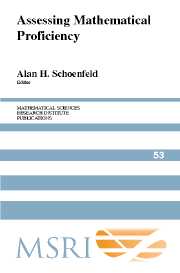Book contents
- Frontmatter
- Contents
- Preface
- Acknowledgments
- Section 1 The Big Picture
- Section 2 Perspectives on Mathematical Proficiency
- Section 3 What Does Assessment Assess? Issues and Examples
- Section 4 The Case of Algebra
- Section 5 What Do Assessments Assess? The Case of Fractions
- Section 6 The Importance of Societal Context
- 17 Assessment in France
- 18 Assessment to Improve Learning in Mathematics: The BEAR Assessment System
- 19 English Learners and Mathematics Learning: Language Issues to Consider
- 20 Beyond Words to Mathematical Content: Assessing English Learners in the Mathematics Classroom
- 21 Assessment in the Real World: The Case of New York City
- 22 Perspectives on State Assessments in California: What You Release Is What Teachers Get
- Epilogue: What Do We Need to Know? Items for a Research Agenda
- About the Authors
- Subject Index
- Author Index
- Task Index
22 - Perspectives on State Assessments in California: What You Release Is What Teachers Get
Published online by Cambridge University Press: 06 July 2010
- Frontmatter
- Contents
- Preface
- Acknowledgments
- Section 1 The Big Picture
- Section 2 Perspectives on Mathematical Proficiency
- Section 3 What Does Assessment Assess? Issues and Examples
- Section 4 The Case of Algebra
- Section 5 What Do Assessments Assess? The Case of Fractions
- Section 6 The Importance of Societal Context
- 17 Assessment in France
- 18 Assessment to Improve Learning in Mathematics: The BEAR Assessment System
- 19 English Learners and Mathematics Learning: Language Issues to Consider
- 20 Beyond Words to Mathematical Content: Assessing English Learners in the Mathematics Classroom
- 21 Assessment in the Real World: The Case of New York City
- 22 Perspectives on State Assessments in California: What You Release Is What Teachers Get
- Epilogue: What Do We Need to Know? Items for a Research Agenda
- About the Authors
- Subject Index
- Author Index
- Task Index
Summary
In the 1970s, the California Legislature determined that California's curriculum was not well served by national standardized tests and developed its own testing program, the California Assessment Program (CAP). Folklore gives several rationales for this action: urban superintendents wanted to conceal their students' low achievement, which would be revealed with the publication of national norms; consciousness that the California population was more diverse than the U.S. population; or awareness that California's curriculum differed from the national composite used for national tests.
California has had state-wide frameworks to guide district curricula for many years. This story begins with the 1980 addendum to the 1975 framework [California 1982], a small volume that declared “problem solving” to be the umbrella for all of the framework's curricular strands (number, algebra, geometry, statistics, etc.). The task for CAP was to provide the state and districts with information about performance on these strands. It used matrix sampling and item response theory to provide detailed analysis, on the basis of which instructional improvements could be made. CAP was not designed to yield individual student scores; these could continue to come from standardized tests so that parents, teachers, principals, and superintendents could answer the question, “How does this student, this class, this school, or this district stack up in comparison with national norms?”
CAP was designed to provide scores on mathematical topics. It used matrix sampling to make sure that enough kids took items such as “whole number division” or “similar figures” to yield a reliable and valid score.
- Type
- Chapter
- Information
- Assessing Mathematical Proficiency , pp. 357 - 364Publisher: Cambridge University PressPrint publication year: 2007



